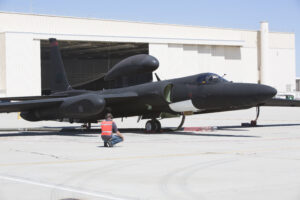
ORLANDO: After much rescheduling and years of skepticism, Northrop Grumman took a step toward finally replacing the revered but aging U-2 spy plane with its Global Hawk drone on Feb. 8, when it flew with and tested UTC’s MS-177 multispectral sensor, which is intended to enable the drone to surpass the legendary U-2.
The day before the start of the Air Force Association’s winter conference, Michael Lyons, head of business development for the high-flying drone, briefed me on the aircraft’s progress. The last major step in beefing up the plane’s sensor suite to push its capabilities beyond those of the U-2 came Oct. 6 when the venerable Optical Bar Camera broad-area synoptic sensor flew on the drone.
The MS-177A, built and designed by United Technologies Aerospace Systems, “was built upon the expertise and success” of the Senior Year Electro-optical Reconnaissance System sensor which has flown on the U-2 for several decades. The new sensor, Lyons says, can be moved to look at threats and provides “very good information out at 100 miles, maybe more. It is a big leap in image capability.” It allows what military commanders call broad area monitoring.

U-2 spy plane
It is the first of three variants. The A model provides 10 bands; the B model hundreds of bands, making it hyperspectral, and the C variant will be the next generation model. The latter sensors have developmental funding only, Lyons says. No money to integrate them on the Global Hawk is available. Northrop spent $80 million of what the Air Force estimated might cost $600 million to integrate the A sensor on the drone.
The Office of Secretary of Defense and Congress like the Global Hawk much more than they did a few years ago, principally because Northrop slashed its per-hour operations costs. Those costs sank from $42,000 an hour in 2011 to roughly $14,500 last year. Lyons says they haven’t dropped in the last four months and he doesn’t expect they will drop much more in the short term.
The new sensors physical use by the Global Hawk is made possible by Northrop’s Universal Payload Adapter. The Air Force’s Open Mission Systems standard makes the adapter’s use possible.
Formally adopted two years ago, the Open Mission Systems (OMS) standard aims to foster competition on subcontracts by adopting the cell phone apps model. Just as Apple publishes standards for integrating technologies that allow other companies to develop applications that work with its iPhone, Open Mission Systems has prime aircraft contractors publish system architecture standards so other companies can make communications, radar and other mission technologies that work with the prime contractor’s platform.
While other companies, including Lockheed, are testing sensors to demonstrate they can be used on aircraft using OMS, Lyons notes Northrop is “fielding OMS, not just talking about it.”
The battle between Lockheed Martin’s U-2 and Global Hawk has been gently epic.The Global Hawk Block 30 got retired. But it had congressional friends. Then the U-2 was retired in the 2015 budget. Now the U-2’s “retirement” has been put on hold ’til 2019 in the 2017 defense budget and we don’t know what’s in the 2018 defense budget and probably won’t for a month or two.
And in a tidbit sure to infuriate any reporter, Lyons told me at the end of today’s interview that Northrop is talking with the Air Force Research Lab “about new sensors.” He declined to provide any hints or details. From the look on his face, some of them must offer potentially impressive new capabilities.
Taking aim: Army leaders ponder mix of precision munitions vs conventional
Three four-star US Army generals this week weighed in with their opinions about finding the right balance between conventional and high-tech munitions – but the answers aren’t easy.


























